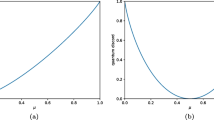Summary
We investigate how the second-sheet singularities of the matrix elements of the resolvent operator depend on the dense set of states on which they are evaluated. We illustrate the fact that, for a given Hamiltonian, one can choose a dense set of states such that the corresponding matrix elements of the resolvent can be continued across the spectrum into the lower half-plane and exhibit therein singularities at arbitrary preassigned locations. This shows that, given a resonant dynamics, some further physical input is needed in addition to the assignement of the total Hamiltonian, in order to identify privileged dense sets of states for which the singularities of the analytic continuation of the matrix elements of the resolvent have a physical meaning as characterizing the unstable states of the system. We develop these considerations explicitly in the examples of a nonrelativistic spinless particle subject to a local central potential or to a degenerate interaction. In the above cases, we show that a privileged set can either be chosen to be the set of states which are entire functions in the representation in which the free Hamiltonian is diagonal or, equivalently, the set of spatially localized states. The close connection with the preparation procedure of an unstable state as a localization process is discussed.
Riassunto
Si studia come le singolarità degli elementi di matrice dell’operatore risolvente dipendano dall’insieme ovunque denso di stati su cui essi sono valutati. Si mostra che, per una data hamiltoniana, si può scegliere un insieme ovunque denso di stati, tale che gli elementi di matrice del risolvente possano essere continuati analiticamente attraverso lo spettro nel secondo foglio di Riemann e si possa far in modo che le loro singolarità ivi si presentino in posizioni arbitrariamente prefissate. Questo implica che, assegnata una dinamica risonante, è necessaria qualche ulteriore ipotesi fisica per poter identificare insiemi ovunque densi di stati, tali che le singolarità della continuazione analitica degli elementi di matrice del risolvente abbiano un significato fisico e possano perciò essere utilizzati per caratterizzare gli stati instabili del sistema. Si discutono in dettaglio gli esempi di una particella non relativistica senza spin in un potenziale centrale e locale o in un potenziale non locale degenere. In questi casi si mostra che un insieme ovunque denso di stati con le proprietà sopra elencate può ottenersi o usando gli stati i cui rappresentativi sulla base dell’hamiltoniana imperturbata risultano essere funzioni intere o, equivalentemente, l’insieme degli stati spazialmente localizzati. Le relazioni esistenti con i procedimenti di preparazione di un sistema instabile sono pure discussi.
Резюме
Мы исследуем, как синтулярности на втором листе матричных элементов оператора резольвенты зависят от системы состояний, по которым они вычисляются. Мы доказываем факт, что для заданного Гамильтониана можно так выбрать системы состояний, что соответствуюшие матричные элементы могут быть продолжены в нижнюю полуплоскость и обнаруживают синтулярности в заданных точках. Показывается, что для заданной резонансной динамики необходимы некоторые дополнительные физические данные в дополнение к заданию полного Гамильтониана, чтобы идентифицировать привилегированные системы состояний, для которых сингулярности аналитического продолжения матричных элементов резольвенты имеют физический смысл характеристик нестабильных состояний системы. Мы развиваем такой подход в явном виде на примерах нерелятивистской бесспиновой частицы, находящейся в поле локального центрального потенциала или под действием вырожденночо взаимодействия. В вышеуказанных случаях мы показываем, что привилегированная система может быть выбрана как система состояний, которые представляются целыми функциями в представлении, в котором свободный Гамильтониан является диагональным, или, эквивалентно, как система локализованных состояяний. Обсуждается тесная связь с процедурой приготовления нестабильного состояния, как процесса локализации.
Similar content being viewed by others
References
This problem has been debated, for instance, in the session on decaying systems at theSeventh International Colloquium on Group Theoretical Methods in Physics held in Austin, Texas, in 1978. See alsoG. Parravicini, V. Gorini andE. C. G. Sudarshan:Resonances, scattering theory and rigged Hilbert spaces, preprint University of Texas at Austin (1979) (submitted toJ. Math. Phys. (N. Y.)).
See,e.g.,M. Reed andB. Simon:Methods of Modern Mathematical Physics, Vol.4 (New York, N. Y., 1978), sect. XII.6, XIII.10, and references contained therein.
V. De Alfaro andT. Regge:Potential Scattering (Amsterdam, 1965).
K. O. Friedrichs:Commun. Pure Appl. Math.,1, 361 (1948);T. D. Lee:Phys. Rev.,95, 1329 (1954).
L. Fonda andG. C. Ghirardi:Nuovo Cimento A,67, 257 (1970).
L. Fonda, G. C. Ghirardi, A. Rimini andT. Weber:Nuovo Cimento A,15, 689 (1963);18, 805 (1973).
R. G. Newton:Scattering Theory of Waves and Particles (New York N. Y., 1966).
Author information
Authors and Affiliations
Additional information
Supported in part by INFN, Sezioni di Trieste e Milano, by NATO Research Grant No. 1380 and by CNR Research Contract No. 77.01543.63.
Перевебено ребакцией.
Rights and permissions
About this article
Cite this article
Ghirardi, G.C., Gorini, V. & Parravicini, G. Spatial localization of quantum states and physical meaning of the matrix elements of the resolvent operator. Nuov Cim A 57, 1–20 (1980). https://doi.org/10.1007/BF02832943
Received:
Published:
Issue Date:
DOI: https://doi.org/10.1007/BF02832943




